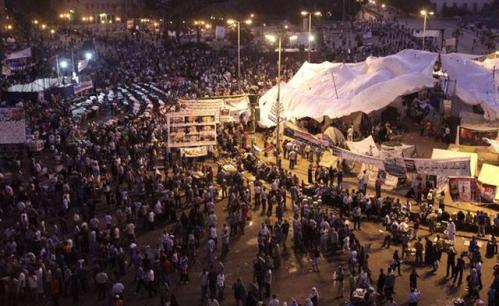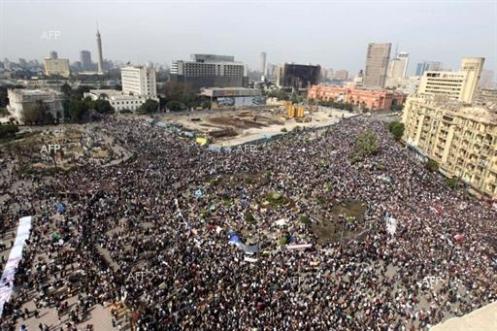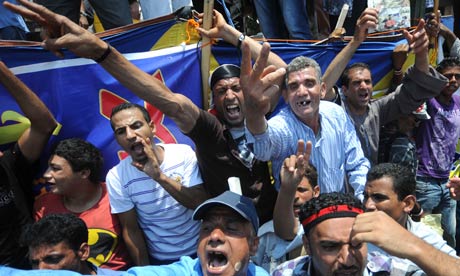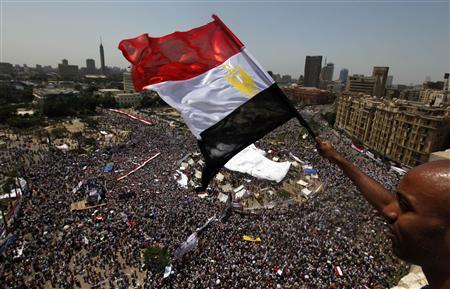|
|
| Thousands of Egyptians in the city of Suez at the Suez Canal on July 8, 2011 continue to fight back after the Egyptian military co-opted their revolution and retrenched on July 8, 2011. Untold thousands across the country have demonstrated the resiliency of this revolution, refusing to accept the regime's attempt to pacify them with the mask of reform. (photo -AFP/Getty Images) |
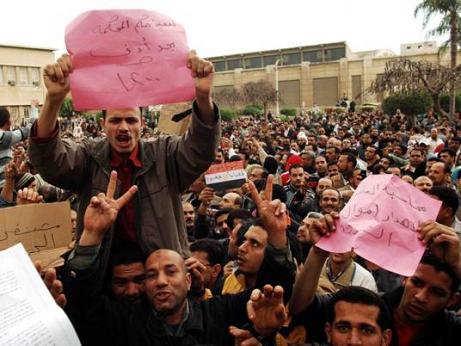 |
| Egyptian Textile, Railway, Suez Canal workers and others have gone on strike since February, 2011 fueling massive protests across the country against the US-backed regime. The strikes began in 2004, escalated in 2006 and reached a critical mass this year. In February, some 20,000 workers went on strike at the state-owned Mahalla Textile Company despite warnings from the Supreme Council of the Armed Forces against labor protests. In June Egyptian workers continued, defying the new anti-strike laws proposed in March by the regime. |
|
|
|
Again on July 15, tens of thousands packed city centers across the country. Protesters in this photo wave their national flag and shout slogans in Cairo's Tahrir Square. Photo: Mohamed Hossam/AFP/Getty Images |
|
|
| On July 12 protestors remain in Tahrir Square in Cairo in spite of the intense heat, demanding the regime propped up by the U.S., step down. A number of protestors were taken to hospitals after dropping from heat exhaustion. |
|
|
| On Sunday, July 10 Egypt's revolutionaries protest beneath a big banner with pictures of government officials and reads “The military council protects the former regime.” |
|
|
| The people filled Tahir Square on July 10, refusing to be ignored by the military junta. |
|
|
| Chanting and shouting slogans against the regime on July 10. "We will not go away!" |
|
|
| On July 9, 2011 revolutionaries remain in Tahrir Square as a hunger strike that began on January 20 has been joined by others in recent weeks. In January, the protesters decided that one person would join the hunger strike every 15 minutes until Mubarak relinquishes power. Some strikers raised banners that said, “We will strike until Mubarak goes.” It is reported that there are more than 25 hunger strikers in cities of Suez, Islam El-Hadry and others. The first two protestors in the most recent wave of hunger strikers were journalist Amira El-Adly and protester Mohamed Fawzy in Tahrir Square. It is difficult to know the duration of these hunger strikes or whether they are relayed from some to others for periods of times. But the hunger strikes are an indication of the fervor and intensity of the Egyptians rejection of Mubarak or the current military regime protecting him and others. |
|
|
| An Egyptian waves a national flag as protesters gather in Tahrir square in Cairo July 8, 2011. Workers' strikes and continued public revolt threaten to paralyze Egyptian life and commerce in the most populous nation in the Arab world. protesters threatened to grind life in the Arab world's most populous nation. Photo: Mohamed Abd El-Ghany |
|
|
| July 8, 2011, the people pack Tahrir Square which has been a media center for public revolt in cities across Egypt. The corporate media has portrayed their demands as limited to justice for Mubarak and others. But the revolution finds its roots in strikes and movements by workers and trade unions to end capitalist domination of the Egyptian labor and economy and pro-Israel US-backed puppets running their country. (photo: Reuters) |
(Photos from agencies added by Axis of Logic and related comments by Les Blough, editor. Sources: News Agencies)
16 July 2011
WSWS
by Niall Green
Huge protests took place across Egypt on Friday. Under the banner, “The Friday of Final Warning,” tens of thousands gathered in Cairo’s Tahrir Square and the industrial city of Suez. Many smaller demonstrations took place across the country.
It was the second week of mass demonstrations in Egypt, as working people and youth voiced opposition to the military-dominated government that took over power after the ouster of Hosni Mubarak in February. The Supreme Council of the Armed Forces (SCAF) is the ultimate power in the country; its generals, who were an integral part of the Mubarak dictatorship, have maintained Egypt’s repressive state apparatus and subservient relationship with US imperialism.
There is growing hostility to the regime, which is seen as shielding Mubarak, his family and top officials, as well as members of the security services responsible for the torture and killing of thousands of protesters during the February uprising.
Following last week’s protests, the SCAF announced Wednesday that 700 senior police officers linked to attacks on demonstrators would be moved from their posts. Under the plan, some officers would be offered early retirement and others would be relocated or promoted.
Interior Minister Mansour El-Essawy claimed the move was the “biggest reshuffle in the police force’s history,” and that new recruits hired to replace those departing would “pump fresh blood in to the system.”
The token gesture had no discernible impact of the mood on the streets across Egypt on Friday. “It’s just theatre,” one protester camped out in Tahrir Square told Agence France-Presse. “These announcements are not enough,” said another demonstrator. “The priority is to have trials for the murderers of the martyrs.”
A number of those camping in Tahrir Square are on hunger strike to demand the prosecution of Mubarak-era officials.
The military regime has also delayed proposed parliamentary elections. The vote had been expected to take place in September, but the official Middle East News Agency reported that the date has been pushed back to November.
Despite the blazing summer sun, which caused some protesters to pass out from heatstroke, huge crowds gathered in Tahrir Square all day. They chanted slogans demanding an end to military-dominated government and a purge of Mubarak’s cronies from positions of power.
Al Ahram reported that thousands of copies of a leaflet titled “We demand prosecution, the gang is still in power” were distributed by revolutionary committees in Tahrir Square. There were calls for pay cuts for top politicians and businessmen, and increases in the minimum wage for workers. Protesters and speakers on the podiums also condemned attempts by the regime to pit Christians and Muslims against each other. (emphasis added)
Public rage was directed in particular against ex-President Hosni Mubarak, SCAF leader Field Marshal Hussein Tantawi, and the state media, which has blackguarded the protesters and continues to disseminate pro-regime propaganda.
There were calls for the continuation of strikes and sit-ins at workplaces across the country. Industrial action has been legally banned by the SCAF, though strikes have gripped scores of workplaces throughout Egypt to demand economic and political concession. (emphasis added)
Sit-ins and demonstrations staged in solidarity with the mass gathering in Cairo took place in Suez, Alexandria, the city of Tanta to the north of the capital, the southern city of Luxor, and in many other locations.
The protests in Suez rapidly grew throughout Friday until tens of thousands were gathered in the city’s Arbaeen Square. Well-known poet Mohamed El-Tamsah and several other demonstrators are carrying out a hunger strike in the square to express their opposition to the military regime.
Another march from the Shohada mosque descended on Suez’s main police station to demand the prosecution of officers involved in torture. Videos appeared on the Internet Thursday showing a protester badly injured after being detained by police in the city. Speaking to Ahram Online, Mohamed Mahmoud of the Suez Youth Bloc claimed that six anti-regime activists, including El-Tansah, had been detained and abused by police.
There have been strikes by workers at the Suez Canal Authority, one of Egypt’s main industrial concerns. Workers have threatened to shut down the Suez Canal, a vital world trade route, unless demands for wage increases and the dismissal of corrupt management are met. (emphasis added)
In response to the militancy of the working class, the SCAF have moved thousands of troops to Suez to protect business interests. The Egyptian Third Army deployed forces near banks, police stations, industrial estates and the canal.
In Alexandria, hundreds protested against the appointment of Khaled Gharba as the new regional governor. The previous governor of Alexandria, Essam Salem, resigned on Wednesday following weeks of protests and strikes. Demonstrators outside the Ministry of the Interior building in the city demanded the ouster of the SCAF and the prosecution of security forces personnel.
A protest also took place outside the exclusive hospital in Sharm El Sheikh where Mubarak is residing. Demonstrators called for the deposed president to be transferred to a prison hospital and to face immediate trial for the crimes committed during his 30-year rule.
Despite the massive popular opposition to the SCAF-led regime, many of the organizers of the protests continue to sow illusions in the generals and the bourgeois state.
Abdul-Ezz El-Hariri, a senior member of the Socialist Popular Alliance, called on the SCAF to “act in the spirit of the revolution” or “step down and allow a civilian council to run the transitional phase.”
Two of the main protest groups, the April 6 Movement and the Revolution Youth Coalition, issued a call for civilian government and the resignation of Prime Minister Essam Sharaf. (emphasis added)
The statement, co-signed by the Egyptian Independent Trade Union Association and presidential hopeful Mohamed ElBaradei, claimed that, “Sharaf is an honorable man but he is not fit to lead the country at this stage or to achieve the goals of the revolution in a timely manner.” (Emphasis added.)
The tactical and unprincipled nature of such opposition to the regime was made clear when spokespeople from the April 6 Movement, addressing the crowds in Tahrir Square on Friday, called on Sharaf to form a “revolutionary government.”
Such initiatives serve only to politically disarm the working class. Sharaf and the SCAF leadership are incapable of and opposed to forming a revolutionary government, because they are politically hostile to the working class.
Sharaf was a longstanding member of the Mubarak regime, serving as transportation minister from 2004-2005. While he resigned from the government over a disagreement with then Prime Minster Ahmed Nazif, his differences with the Mubarak regime were over issues of transport infrastructure. After the departure of Mubarak, Sharaf was handpicked by the generals to be the civilian figurehead of their government—precisely because he was a trusted insider, with links to other bourgeois “opposition” leaders such as ElBaradei.
The generals responded to the opposition’s pleas with a July 12 communiqué stating that the SCAF and Sharaf would continue in power, organizing any future elections and participating in writing a permanent constitution. The SCAF statement also warned it would not tolerate any protests that impeded the work of the government.
The statement was delivered on state television by General Mohsen El-Fangary, deputy defense minister and a member of the SCAF. He called on “honorable Egyptian citizens to stand against any attempts to hinder the restoration of normal life.” The general also warned against “spreading rumors” of a rift between the army and the people.
One protester told the WSWS that El-Fangary’s speech was like a pronouncement by Mubarak. “They [the generals] are 100 percent representatives of the Mubarak regime. Like Mubarak in his speeches, they denounce us as criminals who want to destroy the country and spread chaos. The obvious aim of the military council is to threaten us and to mobilize people against the revolution.”
Another “opposition” party boosting the military-dominated regime is the Muslim Brotherhood. A right-wing Islamic organization that was suppressed for years under Mubarak, the Brotherhood is now seeking an accommodation with the military and its backers in Washington. It refused to participate in Friday’s protest and welcomed the threatening SCAF communiqué.
The Brotherhood only reluctantly sent a delegation to last week’s massive demonstration in Tahrir Square, and has repeatedly stated its confidence in Tantawi and the military junta to safeguard the “revolution.” They also back Prime Minister Sharaf, urging their supporters to give his government time to implement its policies.
(photos, related comments and emphases added by Axis of Logic)
Source: WSWS


